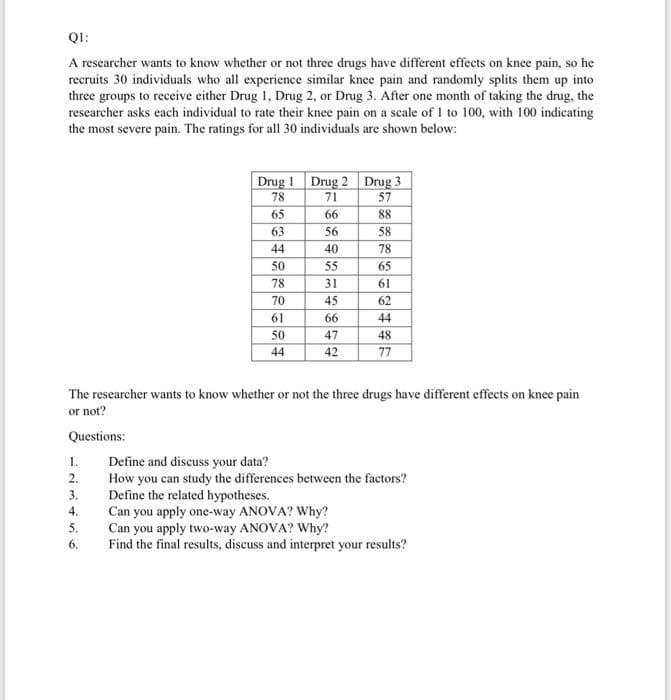QI: A rescarcher wants to know whether or not three drugs have different effects on knee pain, so he recruits 30 individuals who all experience similar knee pain and randomly splits them up into three groups to receive either Drug 1, Drug 2, or Drug 3. After one month of taking the drug, the researcher asks each individual to rate their knee pain on a scale of I to 100, with 100 indicating the most severe pain. The ratings for all 30 individuals are shown below: Drug 1 Drug 2 Drug 3 71 78 57 65 66 88 63 56 58 44 40 78 50 55 65 78 31 61 70 45 62 61 66 44 50 47 48 44 42 77 The researcher wants to know whether or not the three drugs have different effects on knee pain or not? Questions: Define and discuss your data? How you can study the differences between the factors? Define the related hypotheses. 1. 2. 3.
QI: A rescarcher wants to know whether or not three drugs have different effects on knee pain, so he recruits 30 individuals who all experience similar knee pain and randomly splits them up into three groups to receive either Drug 1, Drug 2, or Drug 3. After one month of taking the drug, the researcher asks each individual to rate their knee pain on a scale of I to 100, with 100 indicating the most severe pain. The ratings for all 30 individuals are shown below: Drug 1 Drug 2 Drug 3 71 78 57 65 66 88 63 56 58 44 40 78 50 55 65 78 31 61 70 45 62 61 66 44 50 47 48 44 42 77 The researcher wants to know whether or not the three drugs have different effects on knee pain or not? Questions: Define and discuss your data? How you can study the differences between the factors? Define the related hypotheses. 1. 2. 3.
Glencoe Algebra 1, Student Edition, 9780079039897, 0079039898, 2018
18th Edition
ISBN:9780079039897
Author:Carter
Publisher:Carter
Chapter4: Equations Of Linear Functions
Section4.5: Correlation And Causation
Problem 15PPS
Related questions
Question

Transcribed Image Text:QI:
A researcher wants to know whether or not three drugs have different effects on knee pain, so he
recruits 30 individuals who all experience similar knee pain and randomly splits them up into
three groups to receive either Drug 1, Drug 2, or Drug 3. After one month of taking the drug, the
researcher asks each individual to rate their knee pain on a scale of 1 to 100, with 100 indicating
the most severe pain. The ratings for all 30 individuals are shown below:
Drug 1 Drug 2 Drug 3
71
78
57
65
66
88
63
56
58
44
40
78
50
55
65
78
31
61
70
45
62
61
66
44
50
47
48
44
42
77
The researcher wants to know whether or not the three drugs have different effects on knee pain
or not?
Questions:
Define and discuss your data?
How you can study the differences between the factors?
Define the related hypotheses.
Can you apply one-way ANOVA? Why?
Can you apply two-way ANOVA? Why?
1.
2.
3.
4.
5.
6.
Find the final results, discuss and interpret your results?
Expert Solution
This question has been solved!
Explore an expertly crafted, step-by-step solution for a thorough understanding of key concepts.
This is a popular solution!
Trending now
This is a popular solution!
Step by step
Solved in 2 steps with 1 images

Recommended textbooks for you

Glencoe Algebra 1, Student Edition, 9780079039897…
Algebra
ISBN:
9780079039897
Author:
Carter
Publisher:
McGraw Hill

Holt Mcdougal Larson Pre-algebra: Student Edition…
Algebra
ISBN:
9780547587776
Author:
HOLT MCDOUGAL
Publisher:
HOLT MCDOUGAL

Functions and Change: A Modeling Approach to Coll…
Algebra
ISBN:
9781337111348
Author:
Bruce Crauder, Benny Evans, Alan Noell
Publisher:
Cengage Learning

Glencoe Algebra 1, Student Edition, 9780079039897…
Algebra
ISBN:
9780079039897
Author:
Carter
Publisher:
McGraw Hill

Holt Mcdougal Larson Pre-algebra: Student Edition…
Algebra
ISBN:
9780547587776
Author:
HOLT MCDOUGAL
Publisher:
HOLT MCDOUGAL

Functions and Change: A Modeling Approach to Coll…
Algebra
ISBN:
9781337111348
Author:
Bruce Crauder, Benny Evans, Alan Noell
Publisher:
Cengage Learning

Big Ideas Math A Bridge To Success Algebra 1: Stu…
Algebra
ISBN:
9781680331141
Author:
HOUGHTON MIFFLIN HARCOURT
Publisher:
Houghton Mifflin Harcourt